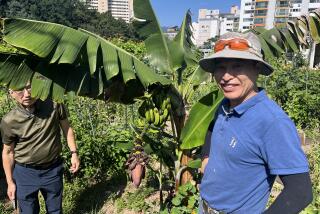Tree sap turns table on bug trap plant
Some 40 million years ago around the Baltic Sea coast, an insect-killing plant was busy trapping bugs. Its leaves, about as long as a pencil eraser, eventually fell into sticky sap, which hardened to amber and stayed there until miners scooped it up, cut it with a dental drill, polished it up and sold it to a collector in Hamburg, Germany.
A closer look at the amber specimen reveals the oldest-known fossil of a carnivorous plant, probably an ancestor of a very rare species now found only in South Africa, according to a study published online Monday in the journal Proceedings of the National Academy of Sciences.
The closest modern species, Roridula gorgonias, traps insects but does not produce the enzymes to digest them, according to the study. Instead, it depends on a capsid bug to feed on the prey, and leave behind droppings that the plant then uses for nutrients.
That’s right: It eats bug poop. And its ancestor probably did the same, forming a symbiotic relationship with just one species of bug.
“Bugs feed on the trapped insects, and their fecal pellets are deposited on the leaf surface, and the leaf surface has a lot of tiny, nanometer-sized gaps, so it has the chance to uptake these nutrients from the bug species into the plant,” said biologist Alexander Schmidt of the University of Gottingen, Germany, lead investigator of the study.
Schmidt said the similarities between plant parts of the fossil and those on the modern species suggest the relationship with an unknown helper bug began at least 35 million to 47 million years ago, a time range that is consistent with genome analysis of the modern plant. Each has a type of hair-like appendage along with a tentacle topped with a gland that secretes a sticky substance to trap insects, according to the study.
What the whole plant looked like, however, is anyone’s guess. “Unfortunately, we don’t know how the entire plant looked because we only have two leaves. This is the tragedy of the plant fossil record – mostly there are just stems, or bark, or leaves, or flower, or fruit, but rarely is the entire plant preserved.”
Hundreds of thousands of insects and other arthropods have been identified in the amber deposits near Kaliningrad, Russia, Schmidt said. But plant species, along with fungi and lichens, can be more helpful to piece together the ancient ecosystem along what now is the Baltic Sea.
“We don’t know whether it was a dense forest with sparse light on the forest floor, or was it more open woodland, or a large area with everything – forests and meadows and swamps and rivers and ponds?” Schmidt said. “We think the latter is the case.”
During the Eocene epoch, about 34 million to 55 million years ago, Europe was isolated from Asia and much warmer than today, Schmidt said. The amber-bearing sediments at the Jantarny amber mine date to 35 million to 47 million years ago.
Hundreds of tons of amber have been dug from the mine since the 19th century, so it may never be known what other ancient flora and fauna have been lost to science. The specimen Schmidt’s team examined came from the private collection of Christel and Hans Werner Hoffeins, of Hamburg, according to the study.
“We have very good cooperation with collectors, and of course with museums, to exchange and loan pieces,” Schmidt said. “There are many more fossils around than we actually see, and many fossils decay close to the surface without ever being found, so it’s always a matter of luck and accidental discoveries.”
Don’t leave science to luck. Follow me on Twitter: @LATsciguy







